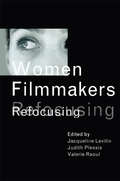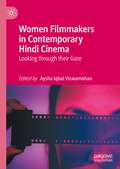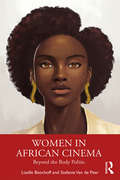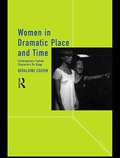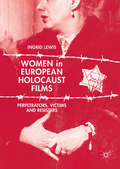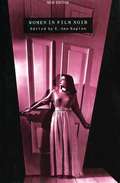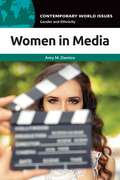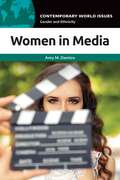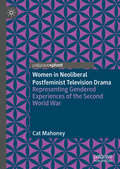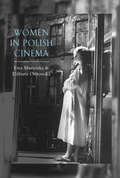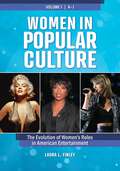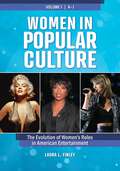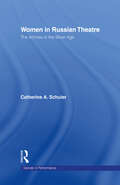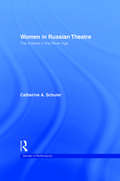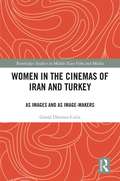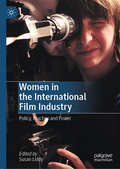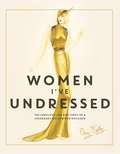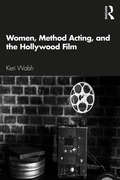- Table View
- List View
Women Filmmakers: Refocusing
by Jacqueline Levitin Judith Plessis Valerie RaoulThis wide-ranging volume of new work brings together women filmmakers and critics who speak about what has changed over the past twenty years. Including such filmmakers as Margarethe von Trotta, Deepa Mehta, and Pratibha Parmar, and such critics as E. Ann Kaplan, this comprehensive volume addresses political, artistic, and economic questions vital
Women Filmmakers: Refocusing
by Jacqueline Levitin Judith Plessis Valerie RaoulThis wide-ranging volume of new work brings together women filmmakers and critics who speak about what has changed over the past twenty years. Including such filmmakers as Margarethe von Trotta, Deepa Mehta, and Pratibha Parmar, and such critics as E. Ann Kaplan, this comprehensive volume addresses political, artistic, and economic questions vital
Women Filmmakers in Contemporary Hindi Cinema: Looking through their Gaze
by Aysha Iqbal ViswamohanThis book is a comprehensive anthology comprising essays on women film directors, producers and screenwriters from Bollywood, or the popular Hindi film industry. It derives from the major theories of modernity, postmodern feminism, semiotics, cultural production, and gender performativity in globalized times. The collection transcends the traditional approaches of looking at films made by women filmmakers as ‘feminist’ cinema, and focuses on an extraordinary group of women filmmakers like Ashwini Iyer Tiwari, Bhavani Iyer, Farah Khan, Mira Nair Vijaya Mehta, and Zoya Akthar. The volume will be of interest to academics and theorists of gender and Hindi cinema, as well as anybody interested in contemporary Hindi films in their various manifestations.
Women in African Cinema: Beyond the Body Politic
by Lizelle Bisschoff Stefanie Van de PeerWomen in African Cinema: Beyond the Body Politic showcases the very prolific but often marginalised presence of women in African cinema, both on the screen and behind the camera. This study provides the first in-depth and sustained study of women in African cinema. Films by women from different geographical regions are discussed in case studies that are framed by feminist theoretical and historical themes, and seen through an anti-colonial, philosophical, political and socio-cultural cinematic lens. A historical and theoretical introduction provides the context for thematic chapters exploring topics ranging from female identities, female friendships, women in revolutionary cinema, motherhood and daughterhood, women’s bodies, sexuality, and spirituality. Each chapter serves up a theoretical-historical discussion of the chosen theme, followed by two in-depth case studies that provide contextual and transnational readings of the films as well as outlining production, distribution and exhibition contexts. This book contributes to the feminist anti-racist revision of the canon by placing African women filmmakers squarely at the centre of African film culture. Demonstrating the depth and diversity of the feminine or female aesthetic in African cinema, this book will be of great interest to students and scholars of African cinema, media studies and African studies.
Women in African Cinema: Beyond the Body Politic
by Lizelle Bisschoff Stefanie Van de PeerWomen in African Cinema: Beyond the Body Politic showcases the very prolific but often marginalised presence of women in African cinema, both on the screen and behind the camera. This study provides the first in-depth and sustained study of women in African cinema. Films by women from different geographical regions are discussed in case studies that are framed by feminist theoretical and historical themes, and seen through an anti-colonial, philosophical, political and socio-cultural cinematic lens. A historical and theoretical introduction provides the context for thematic chapters exploring topics ranging from female identities, female friendships, women in revolutionary cinema, motherhood and daughterhood, women’s bodies, sexuality, and spirituality. Each chapter serves up a theoretical-historical discussion of the chosen theme, followed by two in-depth case studies that provide contextual and transnational readings of the films as well as outlining production, distribution and exhibition contexts. This book contributes to the feminist anti-racist revision of the canon by placing African women filmmakers squarely at the centre of African film culture. Demonstrating the depth and diversity of the feminine or female aesthetic in African cinema, this book will be of great interest to students and scholars of African cinema, media studies and African studies.
Women in Dramatic Place and Time: Contemporary Female Characters on Stage
by Geraldine CousinFirst published in 1996. Routledge is an imprint of Taylor & Francis, an informa company.
Women in Dramatic Place and Time: Contemporary Female Characters on Stage
by Geraldine CousinFirst published in 1996. Routledge is an imprint of Taylor & Francis, an informa company.
Women in European Holocaust Films: Perpetrators, Victims and Resisters
by Ingrid LewisThis book considers how women’s experiences have been treated in films dealing with Nazi persecution. Focusing on fiction films made in Europe between 1945 and the present, this study explores dominant discourses on and cinematic representation of women as perpetrators, victims and resisters. Ingrid Lewis contends that European Holocaust Cinema underwent a rich and complex trajectory of change with regard to the representation of women. This change both reflects and responds to key socio-cultural developments in the intervening decades as well as to new directions in cinema, historical research and politics of remembrance. The book will appeal to international scholars, students and educators within the fields of Holocaust Studies, Film Studies, European Cinema and Women’s Studies.
Women in European Holocaust Films: Perpetrators, Victims and Resisters
by Ingrid LewisThis book considers how women’s experiences have been treated in films dealing with Nazi persecution. Focusing on fiction films made in Europe between 1945 and the present, this study explores dominant discourses on and cinematic representation of women as perpetrators, victims and resisters. Ingrid Lewis contends that European Holocaust Cinema underwent a rich and complex trajectory of change with regard to the representation of women. This change both reflects and responds to key socio-cultural developments in the intervening decades as well as to new directions in cinema, historical research and politics of remembrance. The book will appeal to international scholars, students and educators within the fields of Holocaust Studies, Film Studies, European Cinema and Women’s Studies.
Women in Film Noir
by E. Ann KaplanThe first edition of 'Women in Film Noir' (1978) assembled a group of scholars and critics committed to understanding the cinema in terms of gender, sexuality, politics, psychoanalysis and semiotics. This edition is expanded to include further essays which reflect the renewed interest in Film Noir. Exploring 'neo-noir', postmodernism and other contemporary trends, new essays offer readings of, among others, 'Bound' and 'Basic Instinct', broadening the scope of the book to include questions of race and homosexuality.
Women in Film Noir
The first edition of 'Women in Film Noir' (1978) assembled a group of scholars and critics committed to understanding the cinema in terms of gender, sexuality, politics, psychoanalysis and semiotics. This edition is expanded to include further essays which reflect the renewed interest in Film Noir. Exploring 'neo-noir', postmodernism and other contemporary trends, new essays offer readings of, among others, 'Bound' and 'Basic Instinct', broadening the scope of the book to include questions of race and homosexuality.
Women in Media: A Reference Handbook (Contemporary World Issues)
by Amy M. DamicoThis title provides a broad overview of how women are portrayed and treated in America's news and entertainment industries, including film, television, radio, the internet, and social media.This book provides a one-stop resource for understanding the participation and representation of women in the U.S. media in such areas as narrative film, scripted television programming, advertising, video games, news, and sports. Coverage is wide-ranging and comprehensive, covering historical developments and trends as well as such relevant issues as gender disparities in pay and advancement opportunities, stereotypical gender portrayals in popular entertainment, sexual harassment in America's media and entertainment industries, and the dearth of positive media representations of women of color.Engaging with this history and reading about current issues related to this topic will be useful to those interested in understanding more about why women's engagement in media—in such roles as performer, journalist, producer, and writer—is important. It will also help readers better understand how and why problematic media representations of women hinder efforts to achieve full gender equality in American society.
Women in Media: A Reference Handbook (Contemporary World Issues)
by Amy M. DamicoThis title provides a broad overview of how women are portrayed and treated in America's news and entertainment industries, including film, television, radio, the internet, and social media.This book provides a one-stop resource for understanding the participation and representation of women in the U.S. media in such areas as narrative film, scripted television programming, advertising, video games, news, and sports. Coverage is wide-ranging and comprehensive, covering historical developments and trends as well as such relevant issues as gender disparities in pay and advancement opportunities, stereotypical gender portrayals in popular entertainment, sexual harassment in America's media and entertainment industries, and the dearth of positive media representations of women of color.Engaging with this history and reading about current issues related to this topic will be useful to those interested in understanding more about why women's engagement in media—in such roles as performer, journalist, producer, and writer—is important. It will also help readers better understand how and why problematic media representations of women hinder efforts to achieve full gender equality in American society.
Women in Neoliberal Postfeminist Television Drama: Representing Gendered Experiences of the Second World War
by Cat Mahoney“In this insightful book, Cat Mahoney offers a fascinating analysis of contemporary TV dramas such as Home Fires, Land Girls and The Bletchley Circle. Developing the idea that history is told through the preoccupations of the present, she argues compellingly that these are postfeminist dramas which work through troubling ideas about heteronormative romance, domesticity, beauty and whiteness, while reinforcing the idea that feminism as a political movement is not necessary. A bold and original contribution to television studies, gender studies and popular history.” ̶ Rosalind Gill, City, University of London, UK By examining contemporary television drama set during and immediately after the Second World War, this book illustrates the ways in which postfeminism has shaped representations of women in contemporary culture. Mahoney offers a new perspective to debates that have previously been concerned with questions of historical accuracy. She argues that depictions of women from the past in modern television drama spawn from the neoliberal postfeminist media climate which originated in the 1990s. These depictions respond to a cultural need to naturalise and de-historicise a version of neoliberal postfeminist femininity that is compatible with the current media climate and far more reflective of the concerns of the present than any “real” or lived experience of women in the past. The result of this process of naturalisation is the assertion that postfeminist values are natural and eternal, rather than a product of the 1980s economic turn and the present political moment. By identifying and interrogating postfeminist norms within four television drama series produced since the 2008 financial crash, this book argues that postfeminism is a dominant structuring force in their depiction of female characters and of the past.
Women in Polish Cinema
by Ewa Mazierska Elzbieta OstrowskaPolish film has long enjoyed an outstanding reputation but its best known protagonists tend to be male. This book points to the important role of women as key characters in Polish films, such as the enduring female figure in Polish culture, the "Polish Mother," female characters in socialist realistic cinema, women depicted in the films of the Polish School, Solidarity heroines, and women in the films from the postcommunist period. Not less important for the success of Polish cinema are Polish women filmmakers, four of whom are presented in this volume: Wanda Jakubowska, Agnieszka Holland, Barbara Sass and Dorota Kędzierzawska, whose work is examined.
Women in Popular Culture [2 volumes]: The Evolution of Women's Roles in American Entertainment [2 volumes]
by Laura L. FinleyIncluding more than 300 alphabetically listed entries, this 2-volume set presents a timely and detailed overview of some of the most significant contributions women have made to American popular culture from the silent film era to the present day.The lives and accomplishments of women from various aspects of popular culture are examined, including women from film, television, music, fashion, and literature. In addition to profiles, the encyclopedia also includes chapters that provide a historical review of gender, domesticity, marriage, work, and inclusivity in popular culture as well as a chronology of key achievements.This reference work is an ideal introduction to the roles women have played, both in the spotlight and behind it, throughout the history of popular culture in America. From the stars of Hollywood's Golden Age to the chart toppers of the 2020s, author Laura L. Finley documents how attitudes towards these icons have evolved and how their influence has shifted throughout time. The entries and essays also address such timely topics as feminism, the #MeToo movement, and the gender pay gap.
Women in Popular Culture [2 volumes]: The Evolution of Women's Roles in American Entertainment [2 volumes]
by Laura L. FinleyIncluding more than 300 alphabetically listed entries, this 2-volume set presents a timely and detailed overview of some of the most significant contributions women have made to American popular culture from the silent film era to the present day.The lives and accomplishments of women from various aspects of popular culture are examined, including women from film, television, music, fashion, and literature. In addition to profiles, the encyclopedia also includes chapters that provide a historical review of gender, domesticity, marriage, work, and inclusivity in popular culture as well as a chronology of key achievements.This reference work is an ideal introduction to the roles women have played, both in the spotlight and behind it, throughout the history of popular culture in America. From the stars of Hollywood's Golden Age to the chart toppers of the 2020s, author Laura L. Finley documents how attitudes towards these icons have evolved and how their influence has shifted throughout time. The entries and essays also address such timely topics as feminism, the #MeToo movement, and the gender pay gap.
Women in Russian Theatre: The Actress in the Silver Age (Gender in Performance)
by Catherine SchulerWomen in Russian Theatre is a fascinating feminist counterpoint to the established area of Russian theatre populated by male artists such as Stanislavsky, Chekov and Meyerhold. With unprecedented access to newly-opened files in Russia, Catherine Schuler brings to light the actresses who had an impact upon Russian modernist theatre. Schuler brings to light the extradordinary lives and work of eight Russian actresses who flourished on the stage between the late nineteenth and early twentieth century.
Women in Russian Theatre: The Actress in the Silver Age (Gender in Performance)
by Catherine SchulerWomen in Russian Theatre is a fascinating feminist counterpoint to the established area of Russian theatre populated by male artists such as Stanislavsky, Chekov and Meyerhold. With unprecedented access to newly-opened files in Russia, Catherine Schuler brings to light the actresses who had an impact upon Russian modernist theatre. Schuler brings to light the extradordinary lives and work of eight Russian actresses who flourished on the stage between the late nineteenth and early twentieth century.
Women in the Cinemas of Iran and Turkey: As Images and as Image-Makers (Routledge Studies in Middle East Film and Media)
by Gonul Donmez-ColinThis volume compares the cinemas of Iran and Turkey in terms of the presence and absence of women on both sides of the camera. From a critical point of view, it provides detailed readings of works by both male and female film-makers, emphasizing issues facing women's film-making. Presenting an overview of the modern histories of the two neighbouring countries, the study traces certain similarities and contrasts, particularly in the reception, adaption and representation of Western modernity and cinema. This is followed by the exploration of the images of women on screen with attention to minority women, investigating post-traumatic cinema's approaches to women (Islamic Revolution of 1979 in Iran and the 1980 coup d’état in Turkey) and women's interpretations of post-traumatic experiences. Furthermore, the representations of sexualities and LGBTI identities within cultural, traditional and state-imposed restrictions are also discussed. Investigating border-crossing in physical and metaphorical terms, the research explores the hybridities in the artistic expressions of 'deterritorialized' film-makers negotiating loyalties to both vatan (motherland) and the adopted country. This comprehensive analysis of the cinemas of Iran and Turkey, based on extensive research, fieldwork, interviews and viewing of countless films is a key resource for students and scholars interested in film, gender and cultural studies and the Middle East.
Women in the Cinemas of Iran and Turkey: As Images and as Image-Makers (Routledge Studies in Middle East Film and Media)
by Gonul Donmez-ColinThis volume compares the cinemas of Iran and Turkey in terms of the presence and absence of women on both sides of the camera. From a critical point of view, it provides detailed readings of works by both male and female film-makers, emphasizing issues facing women's film-making. Presenting an overview of the modern histories of the two neighbouring countries, the study traces certain similarities and contrasts, particularly in the reception, adaption and representation of Western modernity and cinema. This is followed by the exploration of the images of women on screen with attention to minority women, investigating post-traumatic cinema's approaches to women (Islamic Revolution of 1979 in Iran and the 1980 coup d’état in Turkey) and women's interpretations of post-traumatic experiences. Furthermore, the representations of sexualities and LGBTI identities within cultural, traditional and state-imposed restrictions are also discussed. Investigating border-crossing in physical and metaphorical terms, the research explores the hybridities in the artistic expressions of 'deterritorialized' film-makers negotiating loyalties to both vatan (motherland) and the adopted country. This comprehensive analysis of the cinemas of Iran and Turkey, based on extensive research, fieldwork, interviews and viewing of countless films is a key resource for students and scholars interested in film, gender and cultural studies and the Middle East.
Women in the International Film Industry: Policy, Practice and Power
by Susan LiddyThe chapter Experiencing Male Dominance in Swedish Film Production” is available open access under a Creative Commons Attribution 4.0 International License via link.springer.com.
Women I've Undressed: The Fabulous Life and Times of a Legendary Hollywood Designer
by Orry-KellyOrry-Kelly created magic on screen, from Casablanca and The Maltese Falcon to Some Like It Hot. He won three Oscars for costume design. He dressed all the biggest stars, from Bette Davis to Marilyn Monroe. Yet few know who Orry-Kelly really was - until now. Discovered in a pillowcase, Orry-Kelly's long-lost memoirs reveal a wildly talented and cheeky rascal who lived a big life, on and off the set. From his childhood in Kiama to revelling in Sydney's underworld nightlife as a naïve young artist and chasing his dreams of acting in New York, his early life is a wild and exciting ride. Sharing digs in New York with another aspiring actor, Cary Grant, and partying hard in between auditions, he ekes out a living painting murals for speakeasies before graduating to designing stage sets and costumes. When he finally arrives in Hollywood, it's clear his adventures have only just begun. Fearless, funny and outspoken, Orry-Kelly lived life to the full. In Women I've Undressed, he shares a wickedly delicious slice of it.
Women, Method Acting, and the Hollywood Film
by Keri WalshWomen, Method Acting, and the Hollywood Film is the first study dedicated to understanding the work of female Method actors on film. While Method acting on film has typically been associated with the explosive machismo of actors like Marlon Brando and Robert De Niro, this book explores an alternate tradition within the Method—the work that women from the Actors Studio did in Hollywood. Covering the period from the end of the Second World War until the 1970s, this study shows how the women associated with the Actors Studio increasingly used Method acting in ways that were compatible with their burgeoning feminist political commitments and developed a style of feminist Method acting. The book examines the complex intersection of Method acting, sexuality, and gender by analyzing performances such as Kim Hunter’s in A Streetcar Named Desire, Julie Harris’s in The Member of the Wedding, Shelley Winters’s in The Big Knife, Geraldine Page’s in Sweet Bird of Youth, and Jane Fonda’s in Coming Home. Challenging the longstanding assumption that Method acting’s approaches were harmful to women and incompatible with feminism, this book argues that some of Hollywood’s most interesting female actors, and leading feminists, emerged from the Actors Studio in the period between the 1950s and the 1970s. Written for students and scholars of Film Studies, Cultural Studies, Theatre and Performance Studies, and Gender Studies, Women, Method Acting, and the Hollywood Film reshapes the way we think of a central strain in American screen acting, and in doing so, allows women a new stake in that tradition.
Women, Method Acting, and the Hollywood Film
by Keri WalshWomen, Method Acting, and the Hollywood Film is the first study dedicated to understanding the work of female Method actors on film. While Method acting on film has typically been associated with the explosive machismo of actors like Marlon Brando and Robert De Niro, this book explores an alternate tradition within the Method—the work that women from the Actors Studio did in Hollywood. Covering the period from the end of the Second World War until the 1970s, this study shows how the women associated with the Actors Studio increasingly used Method acting in ways that were compatible with their burgeoning feminist political commitments and developed a style of feminist Method acting. The book examines the complex intersection of Method acting, sexuality, and gender by analyzing performances such as Kim Hunter’s in A Streetcar Named Desire, Julie Harris’s in The Member of the Wedding, Shelley Winters’s in The Big Knife, Geraldine Page’s in Sweet Bird of Youth, and Jane Fonda’s in Coming Home. Challenging the longstanding assumption that Method acting’s approaches were harmful to women and incompatible with feminism, this book argues that some of Hollywood’s most interesting female actors, and leading feminists, emerged from the Actors Studio in the period between the 1950s and the 1970s. Written for students and scholars of Film Studies, Cultural Studies, Theatre and Performance Studies, and Gender Studies, Women, Method Acting, and the Hollywood Film reshapes the way we think of a central strain in American screen acting, and in doing so, allows women a new stake in that tradition.
